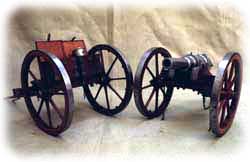Model Cannon and Gun Carriage
 Working model of a seven inch rifled breech loading Armstrong pattern field gun, constructed of the same materials as the full size weapon. The gun is of the type used by the Cinque Ports Volunteer Artillery in 1869.
Working model of a seven inch rifled breech loading Armstrong pattern field gun, constructed of the same materials as the full size weapon. The gun is of the type used by the Cinque Ports Volunteer Artillery in 1869.
Cinque Ports Artillery Volunteers
The Volunteer Movement was created out of a concern for home defence in the early 19th century. The Duke of Wellington was concerned about the country's defences and suggested a force be set up, in a letter of 1847, to Sir John Burgoyne. There was some general opposition to the idea of a force of 'amateur soldiers', but on 12 May 1859 the War Office gave sanction to form a volunteer corps.
The main concern for the volunteer artillery corps was to man the batteries of coastal towns. The 1st Admin. Brigade of Cinque Ports Artillery Volunteers was formed at Dover in 1862. This was made up of 9 Corps, formed around the towns of the Cinque Ports.
1st Corps
On 1 September 1859 a meeting was held for people interested in forming a rifle corps at Dover. At that meeting it was decided 'that for the present the project of forming a rifle corps should be held in abeyance, but that measures should at once be taken for establishing an artillery corps, and with this object between thirty and forty Volunteers gave their names.'
The first meeting 'for the purpose of taking the oath of allegiance, adopting rules, choosing officers and approving uniform to be worn by the corps' was held at the Guildhall on the evening of Monday 5 December 1859. It was to be known as the First Cinque Ports Volunteer Artillery.
A second Company was later formed and the units met for drill in the Wellington Hall on Snargate Street. Lessons in gunnery were held at Archcliffe Fort during business hours, which was inconvenient for some members. In February 1860 two 21 pounder guns were placed in the Butchers Market where evening drill regularly took place.
In March 1860 the artillery volunteers assembled and drilled in full uniform for the first time. This took place on a new drill ground behind Castle Hill Farm.
At the beginning of April it was ordered that the 1st (Dover) Cinque Ports Volunteer Artillery 'instead of forming two distinct companies, should be comprised in a single brigade, to consist of 160 effectives, with a double number of officers.' In July 1860 a Volunteer Concert was held at which the Artillery Corps provided a band.
Further Corps
- 2nd Corps : Folkestone, 1859 (formed as 3rd Kent Artillery Volunteers). Became 2nd Corps 1870
- 3rd Corps : Ramsgate 1860, became 3rd Corps in 1870.
- 4th Corps : formed as 2nd Corps in Sandwich, 1860.
- 5th Corps : Walmer, 1860 (formed as 3rd Corps)
- 6th Corps : Hastings, 1860 (as 4th Corps)
- 7th Corps : Formed as 1st Section of Cinque Ports Artillery Volunteers, 1859, with HQ at Hythe, became 7th Corps in 1860. The Hythe battery never reached battery-strength and was disbanded in 1867. In 1867 a new 5th Corps was founded at St. Leonard's, which became the 7th Corps in 1870.
- 8th Corps : Margate 1861 (as 6th Corps; renumbered 1870).
- 9th Corps : Pevensey, 1866. A 2nd Battery formed 1874.
Source : Norman E. H. Litchfield and Ray Westlake : The Volunteer Artillery, 1859 - 1908, Their Lineage, Uniforms and Badges. The Sherwood Press, Nottingham, 1982